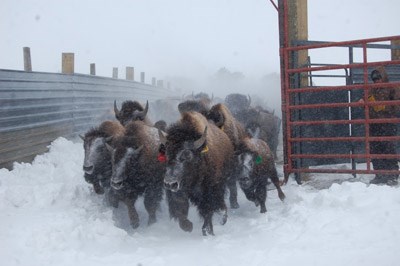Last updated: October 16, 2018
Article
Bison Bellows: The Future of Wild and Domesticated Bison

NPS Photo
For as long as humans have existed, we have always had connections with animals. It seems that our fundamental relationship with animals is primarily utilitarian. We hunt deer for meat, we shelter chickens to harvest eggs, and we sheer sheep for wool. The list goes on and on, because we as humans depend profoundly on animals. The domestication of animals has brought substantial changes not only in our relationship with them, but has also influenced species as a whole---so much so that in some cases, domesticated animals have few similarities to their wild ancestors.
Hundreds of years ago, American Indians were hunting wild, free-ranging bison and using all the body parts to keep them alive. However, the majority of bison alive today are experiencing a shift towards domestication. Today, there are approximately 30,000 wild bison living in conservation herds where managers strive to restore the ecological role of bison as a keystone herbivore in grassland ecosystems. At the same time, there are also roughly 500,000 bison living in private and commercial herds that are managed for meat production and other purposes. It is important to realize that human intervention and the domestication of animals can have consequences. With wild bison in conservation herds, intervention is limited, but with domesticated bison, animal husbandry methods have heavily influenced their reproduction and survival. Indeed, much of the differences between wild bison and domesticated bison are because of two different types of selection: artificial and natural.
When humans intervene with the survival and reproduction of animals, artificial selection occurs. This type of selection is applied in private and commercial bison herds, but can also occur with conservation herds. Different measures such as confinement in fenced areas, roundups, selective culling, vaccinations, and supplemental feeding all constitute artificial selection that can affect both conservation and privately managed bison herds. On the other end of the spectrum, natural selection occurs when bison are subject to natural pressures that affect their life histories such as predation, harsh environmental conditions, and competition for mates and food. Natural selection allows bison to adapt and evolve as well as live and die as their wild ancestors may have with very limited to no human intervention.
Natural selection factors influence the genetics that are passed on from generation to generation, and consequently, wild bison experiencing natural selection most likely have retained important adaptive capabilities to combat these selective factors---something that domesticated bison may be slowly losing due to artificial selection. For example, bison possess physiological adaptations that allow them to survive minus 40 degree temperatures without increasing their metabolism! Domestication can affect genetic diversity, physiological processes, and loss of natural behaviors, significantly altering the evolutionary path of bison. In bison herds that are subject to artificial selection, they are gradually losing their wild characteristics and over time are coming to resemble livestock.
Domestication may not only be altering bison genetics, but the growing number of private and commercial herds for meat production may muddle the general public's understanding of and support for bison conservation. It seems that the demand for bison meat and the confusion surrounding the classification of bison as wildlife or livestock challenges and confounds the conservation and restoration efforts of bison. Ultimately, the future of wild bison in conservation herds depends on how herds are managed (artificially or naturally) and the intensity of management. Recovery of wild bison will require human tolerance of these large mammals ranging freely across large landscapes as well as being subject to natural selection pressures with limited human intervention. Bison must be able to live and die as they naturally would---with predators, natural catastrophes, and managed hunts that would provide more natural checks and balances to ultimately help retain the wild and resilient qualities of this remarkable species.
